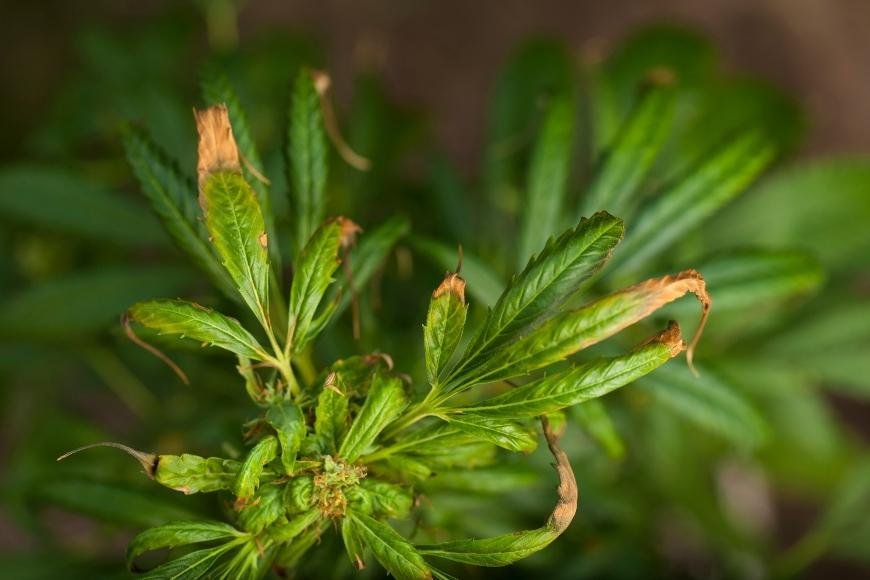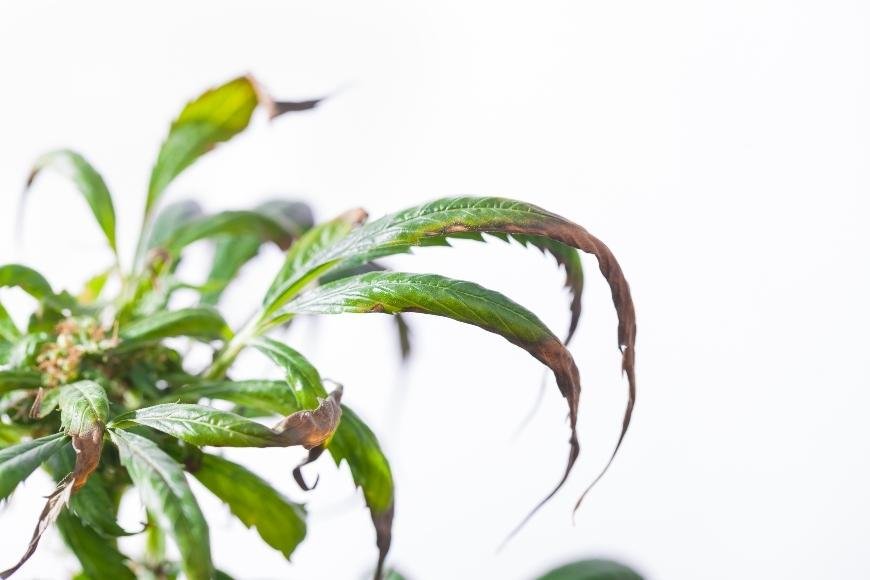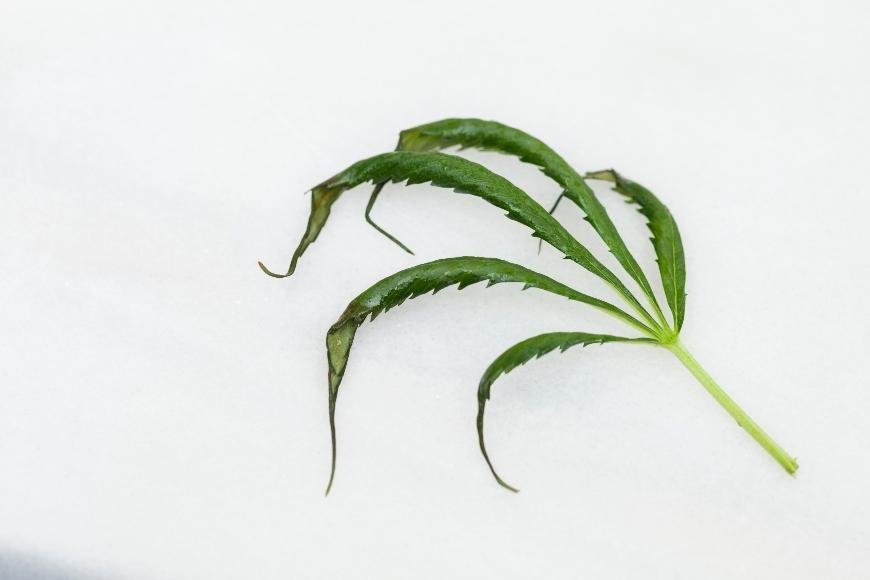Nitrogen Toxicity in Cannabis Plants
Discover how to identify, prevent, and treat Nitrogen Toxicity in Cannabis Plants with our comprehensive guide for healthier and happier plants.

Nitrogen toxicity in cannabis plants is a common issue faced by many recreational growers. Recognizing the telltale signs of excess nitrogen and understanding its impact on your precious crop are essential to effectively address nitrogen toxicity in cannabis plants. In this blog post, we will delve into the world of nitrogen toxicity in cannabis plants.
Our discussion will cover everything from recognizing the telltale signs of excess nitrogen to understanding its impact on your precious crop. We'll also explore various prevention strategies and provide guidance on how to treat affected plants effectively.
By gaining a comprehensive understanding of nitrogen toxicity in cannabis plants, you'll be better equipped to maintain healthy growth cycles and optimize your yield. So let's dive right into this crucial topic!
Table of Contents:
- What is Nitrogen Toxicity?
- The Role of Nitrogen in Cannabis Plants
- Symptoms of Nitrogen Toxicity
- Causes of Nitrogen Toxicity
- Prevention Strategies for Nitrogen Toxicity
- Treating Nitrogen Toxicity
- Benefits of Preventing Nitrogen Toxicity
- Understanding and Addressing Nitrogen Toxicity in Cannabis Plants
- Frequently Asked Questions Nitrogen Toxicity in Cannabis Plants
- Conclusion
What is Nitrogen Toxicity?
Nitrogen toxicity in cannabis crops can be caused by an excessive quantity of the nutrient, leading to harm on growth and health. Nitrogen, a key nutrient for cannabis plants, is necessary to the functioning of photosynthesis, protein formation and chlorophyll creation. However, too much of this essential element can lead to problems that may hinder your plant's development.
Understanding the importance of maintaining proper nitrogen levels is vital for any cannabis grower, whether you're just starting or have been cultivating for years. In this section, we'll delve into what exactly constitutes nitrogen toxicity and how it affects your beloved green babies.
The Role of Nitrogen in Cannabis Plants
- Photosynthesis: Nitrogen helps create chlorophyll molecules responsible for capturing sunlight and converting it into energy through photosynthesis.
- Protein Synthesis: It also aids in producing amino acids required to build proteins necessary for cell growth and repair within the plant structure.
- Vigor & Growth: Adequate amounts of nitrogen contribute to healthy leaf production which supports vigorous vegetative growth during early stages before transitioning into flowering phase.
A balanced supply of nutrients is critical to ensuring optimal conditions throughout each stage of your cannabis plant's life cycle. While having sufficient levels will promote robust development; excess amounts can result in harmful consequences known as "nitrogen toxicity."
Negative Effects Caused by Excess Nitrogen
-
Inhibited Root Development: High nitrogen levels can stunt root growth, limiting the plant's ability to absorb water and other essential nutrients.
-
Delayed Flowering: Excessive nitrogen during the flowering stage may delay bud development or even prevent it altogether, leading to reduced yields.
-
Poor Quality Buds: Overly lush vegetative growth due to excessive nitrogen can result in airy buds with a lower concentration of cannabinoids like THC and CBD, diminishing their potency.
To avoid these pitfalls and ensure your cannabis plants thrive throughout their life cycle, it's crucial to recognize signs of nitrogen toxicity early on. In the following sections, we'll discuss symptoms you should look out for as well as prevention strategies and treatment options available if you suspect an issue with excess nitrogen in your garden.
Symptoms of Nitrogen Toxicity
When it comes to growing cannabis, maintaining a balanced nutrient supply is crucial for healthy plant growth. One common issue that growers may encounter is nitrogen toxicity, which can have detrimental effects on your plants if not addressed promptly. Identifying nitrogen toxicity in cannabis plants is key to preventing detrimental effects, and we'll discuss the symptoms of it here.
- Dark green leaves: The most noticeable sign of nitrogen toxicity is an unusually dark green coloration in the leaves. This occurs because excess nitrogen causes an overproduction of chlorophyll, resulting in a darker hue than normal.
- Slow growth: Excessive amounts of nitrogen can hinder overall plant development by inhibiting other essential nutrients from being absorbed properly. As a result, you may notice stunted growth or slower-than-normal progress in your cannabis plants.
- Burnt leaf tips: Another symptom indicative of nitrogen toxicity is burnt or "clawed" leaf tips. When there's too much nitrogen present, it can cause the edges and tips of leaves to curl downwards and appear scorched due to nutrient burn.
- Limited flowering: High levels of nitrogen during the flowering stage can suppress bud production and lead to reduced yields at harvest time. It's important to monitor your nutrient ratios throughout each phase of growth to ensure optimal results.
Recognizing the signs of nitrogen toxicity can be challenging, but it is critical to detect them in order to stop any further harm. Moving on, we will discuss the causes of nitrogen toxicity and how they can lead to unhealthy cannabis plants.

Causes of Nitrogen Toxicity
Understanding these causes is crucial for preventing and addressing this issue effectively. Here are some common factors that contribute to nitrogen toxicity:
Over-fertilization
One major cause of nitrogen toxicity is over-fertilization. Cannabis growers often use fertilizers rich in nitrogen to promote healthy growth and development during the vegetative stage. Excessive application of fertilizer, resulting in a surplus of nutrients - particularly nitrogen - can cause toxicity.
Inadequate flushing between stages
Different stages of a cannabis plant's life cycle require varying amounts of nutrients. It's essential to flush out any residual nutrients from previous stages before transitioning your plant into the next phase (e.g., from vegetative growth to flowering). Failure to do so may cause leftover nutrients like nitrogen remaining in high concentrations within the growing medium.
Poor quality water source
The water used for irrigation plays a significant role in maintaining optimal nutrient levels for your cannabis plants. If you're using tap water with high mineral content or contaminated with nitrates, it could inadvertently introduce excess amounts of nitrogen into your growing medium.
Tips on choosing good-quality water:
- Avoid using tap water if possible; instead opt for filtered or reverse osmosis (RO) purified water.
- If you must use tap water, let it sit uncovered overnight allowing chlorine and other volatile compounds evaporate.
- Test your water source for contaminants and mineral content using a water test kit.
Unbalanced nutrient solution
An unbalanced nutrient solution can also lead to nitrogen toxicity. When preparing your nutrients, ensure that you're following the recommended ratios provided by the manufacturer or consult an experienced grower. This will help prevent imbalances in essential elements like nitrogen, phosphorus, and potassium (N-P-K).
Prevention Strategies for Nitrogen Toxicity
Preventing nitrogen toxicity in your cannabis plants is essential to ensure healthy growth and a successful harvest. By implementing the following strategies, you can avoid the negative effects of excessive nitrogen and promote optimal plant development:
1. Use a Balanced Nutrient Solution
Selecting a high-quality nutrient solution specifically designed for cannabis plants is crucial. These solutions contain an appropriate balance of nitrogen, phosphorus, potassium, and other essential nutrients that cater to the specific needs of your plants during different stages of growth.
2. Adjust pH Levels Accordingly
Maintaining proper pH levels in your growing medium allows for better nutrient absorption by your cannabis plants' roots. Aim for a pH range between 6.0 and 7.0 when using soil as your growing medium or slightly lower (5.5 - 6) if you're cultivating hydroponically.
3. Monitor Your Plants Regularly
Routinely checking on your cannabis plants will help detect early signs of any potential issues such as nutrient deficiencies or excesses like nitrogen toxicity before they become severe problems affecting overall plant health.
Tips For Monitoring Your Cannabis Plants:
- Daily Visual Inspection: Closely observe leaves' coloration, texture, size & shape regularly to identify any changes indicating possible imbalances in their nutritional intake.
- Track Growth Progress: Maintain a growth journal to document your plants' development, including any adjustments made to nutrient solutions or pH levels.
- Invest in Testing Equipment: Purchase tools like pH meters and TDS (Total Dissolved Solids) testers for accurate measurements of your growing medium's conditions.
4. Gradually Increase Nutrient Concentration
Start with a lower nutrient concentration and incrementally increase it over time to observe the plant's response, thereby ensuring optimal growth. This approach allows you to closely monitor how your plants react to different nutrient levels and make necessary adjustments accordingly.
Incorporating these prevention strategies will help minimize the risk of nitrogen toxicity in your cannabis plants while promoting healthy growth throughout their life cycle. Stay vigilant and attentive when caring for your plants, ensuring they receive just the right amount of nutrients needed for optimal development.
Treating Nitrogen Toxicity
When you suspect that your cannabis plants are suffering from nitrogen toxicity, it's crucial to act quickly and effectively. Treating the issue promptly can help prevent further damage and ensure a successful harvest. Here are some steps you can take to address nitrogen toxicity in your cannabis plants:
1. Flush the Soil with Clean Water
The first step in treating nitrogen toxicity is flushing the soil or growing medium with clean water. This process helps remove excess nutrients, including excessive amounts of nitrogen, from the root zone. To flush your plants properly, use three times the volume of water as there is soil or growing medium in each pot. Make sure to use pH-balanced water for this process.
2. Adjust Your Nutrient Solution
If you're using a nutrient solution for feeding your cannabis plants, consider adjusting its composition by reducing the amount of nitrogen present while maintaining other essential nutrients at appropriate levels. You may also want to switch to a bloom-specific nutrient formula, which typically contains lower levels of nitrogen compared to growth formulas.
3. Monitor pH Levels Regularly
Maintaining proper pH levels plays an essential role in preventing and treating nutrient imbalances like nitrogen toxicity since it affects how well your plant absorbs different elements from its environment. Regularly monitor and adjust pH levels to a range of 6.0 to 7.0 for soil, or 5.5 to 6.5 for hydroponic systems, in order to promote optimal nutrient absorption by the plant and avoid imbalances such as nitrogen toxicity.
4. Prune Damaged Leaves
In some cases, removing severely damaged leaves can help your cannabis plant recover from nitrogen toxicity more effectively by allowing it to focus its energy on healthier growth. However, be cautious not to remove too many leaves at once, as this may stress the plant further.
5. Observe Your Plants Closely
After taking these steps, closely monitor your plants' progress over the next few days or weeks - looking out for signs of improvement or any lingering symptoms of nitrogen toxicity that might require additional intervention.

Benefits of Preventing Nitrogen Toxicity
By understanding the importance of balanced nutrient levels, you can avoid potential issues that may arise from excessive nitrogen. Here are some key benefits of preventing nitrogen toxicity:
- Improved Plant Health: Maintaining proper nutrient levels ensures your cannabis plants receive all the necessary elements to support healthy growth and development. This includes strong root systems, vibrant foliage, and robust stems.
- Increase Yields: A well-nourished plant will produce more flowers with higher potency, leading to an overall increase in yields. Excessive nitrogen can cause slow growth or even damage your plants, resulting in lower yields.
- Better Flavor & Aroma Profile: Cannabis plants grown without excess nutrients tend to have better flavor profiles and aroma due to improved terpene production. Too much nitrogen can lead to harsh flavors when consumed.
- Fewer Pests & Diseases: Healthy cannabis plants are less susceptible to pests and diseases compared to those suffering from nutrient imbalances like nitrogen toxicity. Prevention helps maintain a thriving garden free from unwanted invaders.
- Easier Nutrient Management: Understanding how different nutrients interact within your growing medium allows for easier management of feeding schedules and adjustments as needed throughout the grow cycle. Properly managing nutrients reduces stress on both you as a grower and on your beloved cannabis plants.
Taking steps towards prevention not only improves the health of your cannabis but also makes it easier for you as a cultivator by reducing problems associated with overfeeding or unbalanced nutrition solutions. By keeping a vigilant watch over your plants and furnishing them with the ideal mix of nutrients, you can guarantee that they flourish and deliver top-notch buds for your delight.
Understanding and Addressing Nitrogen Toxicity in Cannabis Plants
By recognizing the symptoms, causes, prevention strategies, and treatment options associated with this issue, you can take proactive steps to maintain optimal plant health.
One crucial aspect of addressing nitrogen toxicity is monitoring your plants regularly for signs of nutrient deficiencies or excesses. This will enable you to catch any issues early on before they escalate into more significant problems that could potentially harm your plants or reduce yields.
- Check leaf color: Keep an eye out for unusually dark green leaves as this may indicate excessive nitrogen levels.
- Monitor growth rates: Slow growth could be a sign that your plants are struggling with too much nitrogen; adjust feeding schedules accordingly if necessary.
- Burnt leaf tips: Burnt or curled leaf tips can also signal an overabundance of nitrogen; consider reducing the amount provided in future feedings if you notice these symptoms persisting.
In addition to regular monitoring, it's important to use a balanced nutrient solution tailored specifically for cannabis plants. Many reputable companies offer specialized products designed just for growing marijuana, which provide all the essential nutrients needed without risking overloading your plants with unnecessary elements like excess nitrogen.
Maintaining proper pH levels within the soil or hydroponic system is another vital aspect of preventing nitrogen toxicity. A pH level that is too high or low can lead to nutrient lockout, causing your plants to struggle with absorbing the nutrients they need for healthy growth. Regularly testing and adjusting pH levels as needed will help ensure your cannabis plants have access to all the essential elements required for optimal development.
Frequently Asked Questions Nitrogen Toxicity in Cannabis Plants
What happens if cannabis has too much nitrogen?
If cannabis plants receive too much nitrogen, they can develop nitrogen toxicity. This condition leads to excessive vegetative growth, dark green leaves with curled tips, and reduced bud production. Over time, the plant's overall health declines as it becomes more susceptible to pests and diseases.
Can cannabis recover from nitrogen toxicity?
Yes, cannabis plants can recover from nitrogen toxicity if addressed promptly. To help your plant bounce back, reduce the amount of nitrogen-rich nutrients you provide and flush the growing medium with pH-balanced water. Monitor your plant closely for improvements in its appearance and growth patterns.
What are the signs of toxicity of nitrogen in plants?
Nitrogen toxicity symptoms include:
- Dark green leaves
- Curling leaf tips (claw-like)
- Inhibited flowering or fruiting
- Lush but weak stems
- Burnt leaf edges due to nutrient burn
How to tell the difference between nitrogen deficiency and toxicity in cannabis?
To differentiate between deficiency and excess nitrogen, deficient plants have yellowing lower leaves that eventually fall off, while toxic ones exhibit dark green foliage with clawed tips.
Conclusion
Overall, nitrogen toxicity in cannabis plants is a serious issue that can cause harm to the plant if not managed properly. Growers should be aware of the signs and sources of nitrogen toxicity to take preventive measures for a successful crop. By using balanced nutrient solutions, adjusting pH levels, monitoring plants regularly and flushing soil with clean water when necessary, growers will be able to ensure their cannabis crops remain healthy and free of any issues related to nitrogen toxicity.




















































































































